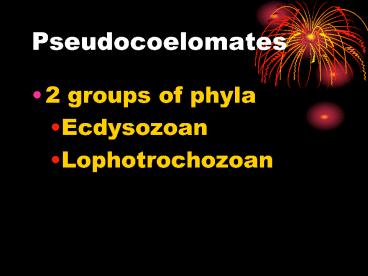Pseudocoelomates - PowerPoint PPT Presentation
1 / 31
Title:
Pseudocoelomates
Description:
Parasites of nearly all animals and plants. Facts, cont. ... Feed on rotifers, tardigrades, annelids, other nematodes ... Tube-within-a-tube digestive system ... – PowerPoint PPT presentation
Number of Views:348
Avg rating:3.0/5.0
Title: Pseudocoelomates
1
Pseudocoelomates
- 2 groups of phyla
- Ecdysozoan
- Lophotrochozoan
2
Ecdysozoan Phyla
- Nematoda
- Nematomorpha
- Kinorhyncha
- Loricifera
- Priapulida
3
Lophotrochozoan Phyla
- Rotifera
- Acanthocephala
- Gastrotricha
- Entoprocta
4
Phylum Nematoda
- Facts
- Pseudoceolom
- 25,000 species
- Parasites of nearly all animals and plants
5
Facts, cont.
- Symmetry bilateral, unsegmented, triploblastic
- No circulatory or respiratory system
6
Niches
- Free-living in all biomes
- Feed on bacteria, yeasts, fungi, algae
- Predatory nematodes
- Feed on rotifers, tardigrades, annelids, other
nematodes - Food source for mites, insects, larvae, fungi
7
Characteristics
- Cylindrical shape
- Juveniles shed nonliving cuticle between each of
4 stages - Most without cilia or flagella
- Express eutely
8
Digestion/Excretion
- Tube-within-a-tube digestive system
- Mouth, muscular pharynx, non-muscular intestine,
rectum, anus - Excretion via large gland, no protonephridia
- Lateral excretory canals
9
Muscles
- Longitudinal muscles only, no circular
- 4 hypodermal cords
- Contractile and noncontractile portions
- Muscle arm extends to nerve
10
Nervous System
- Ring of nerve tissue ganglia around pharynx
- lead to dorsal ventral nerve cords
11
Sense Organs
- Sensory papillae
- At head tail
- Amphids on head
- free-living forms
- Phasmids near posterior
- Parasitic forms
12
Reproduction/Regeneration
- Most dioecious
- Males smaller than females
- Internal fertilization
- Eggs stored in uterus until deposited
13
2 Classes
- Class Secernentea (Phasmida)
- Amphids ventrally coiled or derivative
- 3 esophageal glands
- Some with plasmids
- Free-living or parasitic
14
2 Classes, cont.
- Class Adenophorea (Aphasmida)
- Amphids well-developed, pocketlike
- 5 esophageal glands
- No phasmids
- Most free-living
15
Importance
- Some pathogenic, most tropical
- Large roundworms
- Hookworms
- Trichina worms
- Pinworms
- Filarial worms
16
Large Roundworms
- Ascaris lumbricoides
- In humans
- 64 of people in some areas of SE U.S.
- 1.2 billion people worldwide
- A. megalocephala (horses)
- A. suum (pigs)
17
Ascaris
- 200,000 eggs/day in feces
- Eggsextended viability in soil
- Host swallows eggs
- Juveniles hatch
- Enter blood, to lungs
- Coughed up, swallowed
- Mature in intestine
18
Hookworms
- Necator americanus
- Anterior end hooked
- Dioecious
- Intestinal blood-suckers
- Anemia
19
Hooks Life Cycle
- Adult in intestine
- Eggs pass in feces
- Juveniles hatch in soil
- Live on bacteria
- Burrow through human skin
- Travel in blood to lungs
- Coughed up, swallowed
20
Trichina Worm
- Trichinella spiralis
- Trichinosis
- Infect humans, hogs, rats, cats, dogs
- 2.4 U.S. infected
- Heavy infections cause death
21
Trichina Life Cycle
- Adult in intestine
- Female produces juveniles
- Penetrate skeletal muscle, encyst
- Eat undercooked meat
- Mature in intestine
22
Pinworms
- Most common helminthic parasite in U.S.
- Adults in large intestine and cecum
- Unfertilized eggs yield haploid males
- Fertilized eggs yield diploid females
23
Pinworm Life Cycle
- Females migrate to anal region at night lay
eggs, cause itching - Scratching contaminates hands and bedclothes
- Eggs infective in 6 hours
- Swallowed, hatch, mature
24
Filarial Worms
- 8 species in humans
- Wucheria bancrofti Brugia malayi
- Inflame and block lymphatic system
- Dirofilaria immitis
- Dog heartwormcarried by mosquitoes
25
Human Filarial Worms
- Females release microfilariae into blood lymph
- Mosquitoes ingest microfilariae mature
mosquitoes inject - Elephantiasis
- River blindness (onchocerciasis)carried by black
flies
26
Phylum Nematomorpha
- Horsehair worms
- Adults free-living
- Resemble nematodes
- Juveniles parasites of arthropods
- Stimulate insects to seek water
- Only emerge from host when near water
27
Phylum Kinorhyncha
- 1 mm
- Marine worms
- Cosmopolitan
- Most burrow in mud
- Feed on diatoms
- Cannot swim
- Complete digestive system
28
Phylum Loricifera
- Discovered 1983 in spaces between marine gravel
- 10 species
- Wide distribution
- Feed on bacteria???
29
Phylum Priapulida
- 15 cm
- Cold water burrowing marine worms (deep ocean)
- Eversible proboscis to capture prey
- 16 species
- Complete digestive system
30
Phylogeny
- After deuterostomes diverged from protostomes,
protostomes split - Ecdysozoa
- Molt during development
- Lophotrochozoa
- Lophophore feeding
- Trochophore-like larvae
31
Adaptive Radiation
- Nematodes the most adaptive
- Surviving suboptimal conditions






























